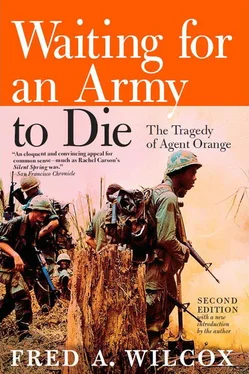5. In contrast to the apparent low toxicity of the four defoliants evidence has been adduced that a contaminant called dioxin found in some of the storage drums has a significant potential toxicity. Although its concentration of dioxin was variable in different drums, it was always found in minute quantities. Experimental evidence from animal studies indicates that this chemical is eliminated from the body fairly rapidly and that it produces its toxic effects rather promptly. All available data suggests that it is not retained in tissues for prolonged periods of time. Accordingly, the recent suggestion by some observers that dioxin might still be detected in the fat tissues of Vietnam veterans exposed to it appears to be implausible.
6. Despite the generally negative results of human and animal studies of the toxicity potential of the Vietnam defoliants, a great deal of concern has been engendered among veterans and their families by media presentations on these agents. The VA is responding to these concerns by working collaboratively with appropriate experts from the federal and private sectors in order to more adequately define the potential human toxicity of the defoliants for humans. You will be periodically informed concerning the results of these efforts.
7. Meanwhile, we request that all VA staff who are called upon to deal with veterans who are concerned about toxic effects from a possible exposure to the defoliants adhere to the following protocol:
A. Every veteran who alleges defoliant exposure must receive prompt, courteous, compassionate consideration.
B. If the veteran has no objective symptoms or signs, simple reassurance should be offered. The veteran should be told that a record of the medical examination will be kept for future reference, but that if the veteran does not now have symptoms and did not previously experience any, the likelihood of herbicide poisoning is virtually zero.
C. If the veteran presents with symptoms and signs which are not clearly explicable in terms of definable disease, a detailed history should be recorded on the VA form 10-10m, including such details the veteran may remember concerning his exposure to defoliant agents. This information can be checked against military data, if indicated.
D. In view of the remaining uncertainties on the long-term effects of the defoliants, all VA personnel should avoid premature commitment to any diagnosis of defoliant poisoning. Similarly, entries in medical records should not contain statements about the relationship between a veteran’s illnesses and defoliant exposure unless unequivocal confirmation of such a connection has been established. Accordingly, veterans in whom defoliant poisoning is suspected should be admitted to a VA hospital for appropriate work-up.
E. If there is evidence suggestive of defoliant agent poisoning, pertinent data must be forwarded to the ADCMD for operations (II), VACO.
F. No veterans other than those referred by DVE should be called in for the express purposes of having them examined for possible defoliant poisoning.
G. All VA forms 10-10m indicating that the veteran or the physician has material concern about the possibility of defoliant poisoning, should be preserved until further notification.
H. A 3×5 locator card should be developed by MAS so that VA forms 10-10m can be swiftly retrieved if the need develops. MAS staff have received instructions on how to develop these cards. Significant administrative problems may be reported to VACO MAS (136D).
I. If a patient who already is hospitalized intimates that he or she may have been exposed to defoliants, a statement to this effect should be entered in the medical record. If there are symptoms or signs which cannot be explained in terms of well-known medical entities, these should be appropriately investigated.
J. Many agricultural and horticultural agents contain the same herbicidal chemicals as were incorporated in the Vietnam defoliants. Whenever there is suspicion of chemical poisoning, therefore, inquiry should be directed to other sources of intoxication as well as the allegations concerning the Vietnam episodes. There also are many industrial sources of chemical intoxication whose manifestations are similar to the syndromes ascribed to the defoliants. A careful occupational history therefore is necessary.
K. Staff of field HFC’s who may be called upon to make public statements concerning the defoliants should not do so before reviewing their proposed expositions with the ADCMD for professional services, whose staff will provide the needed technical guidance.
8. We trust that the foregoing guidance will be sufficient. If new information indicated a change of policy, additional directives will be issued. Should any problem arise which is not covered by this policy statement additional clarification may be sought by calling VACO Medical Service (Dr. Gerrit Schepers, ext. 389-2550). Any freedom of information request should be coordinated with VACO.
Letter from Gilbert Boger, M.D., to the Editor of the Journal of the American Medical Association,
November 30, 1979 (Vol. 242, No. 22)
Symptoms in Vietnam Veterans Exposed to Agent Orange
To the Editor.—Agent Orange is an herbicide containing equal parts of 2,4-dichlorophenoxyacetic acid and 2,4,5-trichlorophenoxyacetic acid. It was used extensively in Vietnam as a defoliant. A toxic contaminant is dioxin, 2,3,7,8-tetrachlorodibenzo- p -dioxin.
A ten-month study of 78 Vietnam veterans who claimed exposure to Agent Orange yielded many findings: 85% of the men experienced a rash that was resistant to treatment. Using immunofluorenscence in one patient, a skin biopsy specimen showed intraepithelial and intercellular IgA, IgG, and IgM. In 53% of the patients, the rash was aggravated by sunlight.
Joint pain occurred in 71%, stiffness in 59%, and swelling in 45%. Hypersomnolence occurred in 44% of the men and extreme fatigue in 80%. Sinus bradycardia and premature ventricular contractions were not infrequent.
Persistent neurological complains were tingling (55%), numbness (60%), dizziness (69%), headaches (35%), and autonomic dyscontrol (18%). Severe psychiatric manifestations were depression (73%), suicidal attempts (8%), and violent rages (45%). An inability to concentrate occurred in 17% and bouts of sudden lapses of memory were seen in 21%. Patients have described fearful episodes of suddenly not knowing where they were going; it was as if their thoughts had left them. There was also a loss of libido in 47%. Three patients died of cancer. Another 10% have been treated for cancer.
The Vietnam veterans demonstrated a large number of gastrointestinal ulcerations. Complaints related to the gastrointestinal tract included anorexia (41%), nausea (59%), vomiting (13%), hematemesis (8%), diarrhea (51%), constipation (31%), and abdominal pain (24%). Hepatitis was reported in 10% and jaundice in 5%.
Nineteen percent of our group had children with gross birth defects. One or more miscarriages were experienced in 13% of the wives. There were reports of sterility; semen analysis showed low sperm counts and abnormal forms.
The two most frequent genitourinary findings were brown urine (23%) and hematuria (9%). A kidney biopsy specimen in one patient was pathological, with an unknown etiology. Other as yet unexplained symptoms were blurred vision (54%), dyspnea (8%), gynecomastia (4%), and galactorrhea (5%).
This group of veterans has in general been chronically ill. Patients complained of frequent infections and allergies. The mean age of the group was 31.7 years. Both upper and lower socioeconomic levels were represented.
The aforementioned information is intended to create an awareness of a substance known as dioxin. This chemical may cause a variety of symptoms, and physicians should be aware of its potential.
Читать дальше











